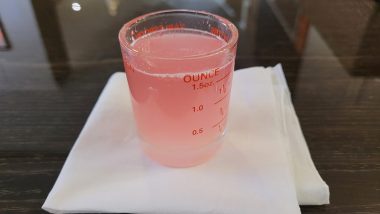Adjusting Our Daughter’s Diet to Better Manage AADC Deficiency
Written by |

A sense of foreboding filled my mind when I first read that there are no approved treatments for aromatic l-amino acid decarboxylase (AADC) deficiency, a condition our 4-year-old daughter, Rylae-Ann, has. I closed my laptop and paced the room but quickly returned to do some research, because fear has never dictated my life.
After searching online, discussing with fellow members of the AADC deficiency community, and talking with doctors, my wife and I developed a special diet for our daughter. We’ve found that the diet acts as a type of treatment for her. Medications have worked for some in the community, but generally, I don’t think they’ve been much help to us. What has helped us are supplements.
Before explaining further, keep in mind that not every patient is the same, so be sure to talk to your healthcare team before taking any supplements or making any adjustments to your diet.
Following is a list of supplements we’ve found to be beneficial. Rylae-Ann had gene therapy, but we still give her these supplements.
Vitamin B6
The active form of vitamin B6, known as pyridoxal 5′-phosphate, is a typical supplement often recommended by doctors. Most families in the AADC deficiency community are aware of vitamin B6 and how it can lead to more production of dopamine and serotonin.
The hardest aspect of vitamin B6 for us was getting Rylae-Ann to take it. She couldn’t swallow pills before she had gene therapy, so we opened the capsule and tried several methods to administer it by masking the bitter, vomit-inducing flavor with other things.

Rylae-Ann eats an ice cream sundae mixed with vitamin B6. (Photo by Richard E. Poulin III)
PS128 probiotic
A proprietary probiotic strain known as Lactobacillus plantarum PS128, from Taiwan-based Bened Biomedical, was shown to ease Parkinson’s symptoms as an add-on treatment to 25 patients in a pilot clinical study, the company announced last year. PS128 can modulate levels of the neurotransmitters dopamine and serotonin, the company said.
According to Bened Biomedical, PS128 is a safe, natural supplement. The company also reported that its patented strain is available in more than 30 countries.
We use two different blends of PS128. The first has additional supplements that support movement and alertness at the start of the day. Another combination helps Rylae-Ann’s social, emotional, and mental state. It tastes excellent, and she has no trouble drinking the contents of the sachet mixed in water.

Before breakfast and dinner, Rylae-Ann has one sachet of PS128 probiotic, which mixes easily in a small amount of water. (Photo by Richard E. Poulin III)
Tryptophan and protein-rich foods
The AADC enzyme synthesizes the neurotransmitters dopamine and serotonin. So we created a diet that aims to support the production and use of dopamine and serotonin as much as possible.
Foods high in the amino acid tryptophan aid the body in serotonin production. By increasing serotonin, we hope to help manage Rylae-Ann’s anxiety. Since she can only eat so many foods in a day, thankfully, foods high in tryptophan are usually high in protein as well. This allows us to make the most of each meal by also supporting muscle development.
Salmon, turkey, and chicken make up the bulk of her meals. Then we find ways to add nuts, eggs, tofu/soybeans, milk, and cheese to her meals or as snacks throughout the day.

Rylae-Ann has a large portion of beef, salmon, turkey, or chicken with every meal. (Photo by Richard E. Poulin III)
Dopamine foods
The delicious tryptophan- and protein-rich foods above also support dopamine production. So we look to add other types of food high in L-tyrosine, an amino acid, as dressings, sides, or snacks. For fruits, we rotate giving her avocados, bananas, strawberries, and blueberries. We mix in spinach, beans, pasta, sweet potatoes, and beets for vegetables.

For her sides, Rylae-Ann enjoys dopamine-supportive foods. (Photo by Richard E. Poulin III)
Omega
When choosing foods, we look for those that overlap in several categories, such as salmon. Another option is to buy fortified foods such as bread, pasta, and even peanut butter.
We reduce saturated fat while increasing the “healthy” omega-3, 6, and 9 fatty acids. Adding this to her diet may mean using it as a dressing or as additives to the foods listed above.
We use the following in our daughter’s diet:
- Omega-3: Salmon, mackerel, chia seeds, flaxseeds, and walnuts.
- Omega-6: Soybean oil, sunflower seeds, almonds, and cashew nuts.
- Omega-9: Olive oil, almonds, cashews, and walnuts.

Rylae-Ann enjoys a fish and soybean meal high in omega fatty acids. (Photo by Richard E. Poulin III)
Fiber
Rylae-Ann gets her daily fiber requirements from her diet and probiotics. However, before she had gene therapy, we had issues with her bowel movements. The more we improved her diet, the better everything moved through her. If she was constipated, we would mix some powder fiber supplements for kids into her milk. We use it as needed, but it could be given daily if necessary.

When necessary, Rylae-Ann’s parents add a fiber supplement to her milk or cereal. (Photo by Richard E. Poulin III)
Lion’s mane mushrooms
The newest supplement we added is a medicinal mushroom called lion’s mane. It has a long history in Chinese medicine, but Western scientific research has also shown that the antioxidants in the mushroom can support brain function. I bought a powdered form of the mushroom, which smells and tastes like broth when mixed with water. It has a taste but isn’t overpowering.

Rylae-Ann’s hearty bowl of beef noodles and eggs with a lion’s mane mushroom broth. (Photo by Richard E. Poulin III)
Over time, we have seen noticeable progress after modifying Rylae-Ann’s diet. We believe in incorporating anything proven to be safe, even if it only adds a slight benefit. As we combined minor improvements together, our daughter achieved significant milestones.
Always remember to talk with your pediatrician before adjusting your child’s diet with supplements. And of course, always be mindful of good feeding practices.
Note: AADC News is strictly a news and information website about the disease. It does not provide medical advice, diagnosis, or treatment. This content is not intended to be a substitute for professional medical advice, diagnosis, or treatment. Always seek the advice of your physician or other qualified health provider with any questions you may have regarding a medical condition. Never disregard professional medical advice or delay in seeking it because of something you have read on this website. The opinions expressed in this column are not those of AADC News or its parent company, Bionews, and are intended to spark discussion about issues pertaining to aromatic l-amino acid decarboxylase deficiency.






Leave a comment
Fill in the required fields to post. Your email address will not be published.